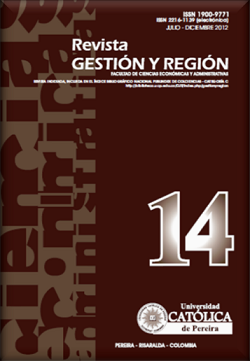Liderazgo, poder e influencia en la organización. Una relación desde las fuentes e instrumentos de poder
Keywords:
Leadership, power, influence, stakeholdersAbstract
Este artículo plantea que en el ejercicio del liderazgo, el líder necesita combinar las fuentes e instrumentos de poder a su disposición y que su autonomía no es completa, debido a los condicionamientos que imponen los grupos de interés de la organización. Para su elaboración se llevó a cabo una revisión bibliográfica que incluyó libros y artículos de revistas científicas de reconocido impacto en el área. Se concluye que la organización es la fuente que aglutina el poder que reciben y perciben sus grupos de interés, quienes condicionan la influencia potencial que puede ejercerse con el liderazgo, en general, y con la participación, en particular.
References
Ammeter, A, Douglas, C, Gardner, W L., Hochwarter, Wayne A. y Ferris, G. (2002). . (6), Toward a political theory of leadership The Leadership Quarterly,13 751–796.
Andersen, A (1998). Diccionario Espasa Economía y Negocios (2ª ed.). Madrid: Espasa.
Araya, J P (2009). Enfoques Teóricos del Liderazgo Aplicados a Pequeñas Organizaciones Chilenas Una visión empírica. Santiago: Universidad de Chile. Escuela de Gobierno y Gestión Pública.
Barbuto Jr, J. (2000). Influence triggers: a framework for understanding follower compliance The Leadership Quarterly. No. 11 . (3), 365–387.
Bass, Bernard M. y Avolio, Bruce J. (Eds.). (1994). Improving organizational effectiveness through transformational leadership. Thousand Oaks, CA: Sage Publications.
Bass, B M. (1990). Bass & Stogdill's handbook of leadership: Theory, research, & managerial applications (3rd ed.). New York: Free Press.
Conger, Jay A. (1991). . Inspiring others: The language of leadership Academy of Management Perspectives. 5(1),31-45.
Daft, R L. (2006). (3ª ed.). La experiencia del liderazgo México: Thomson. Etzioni, Ai. (1964). . Englewood Cliffs, NJ: Prentice-Hall.
Freeman, R. E. (1994). A stakeholder theory of the modern corporation. Perspectives in Business, 50, 38-48.
Freeman, R. E; Wicks, Andrew C., y Parmar, Bidhan (2004). Stakeholder theory and the corporate objective revisited. Organization Science (3), 364-369.
French, J. R. P., y Raven, Bertram. (1960). The bases of social power. In D. Cartwright & A. F. Zander (Eds.), (Pp. 607-623). Evanston, IL: Group dynamics Row, Peterson.
Galbraith, J. K. (1985). (2ª ed.). Barcelona: Plaza & Janés.
García, I y Santa-Bárbara, E S. (2009).Relación entre estilos de liderazgo y bases de poder en las enfermeras Revista Latino-Americana de Enfermagem (RLAE), 17 . (3), 295-301.
Hellriegel, D; Jackson S E. y Slocum, J W. (2010). Administración, un enfoque basado en competencias (11a. ed.). México: Cengage Learning.
Hersey, Paul; Blanchard, Kenneth H. y Johnson, Dewey E. (1998).Administración del Comportamiento Organizacional. Liderazgo Situacional. México: Prentice-Hall Hispanoamérica.
Hoogervorst, Niek; De Cremerc, David; van Dijke, Marius y Mayer, David M. (2012). When do leaders sacrifice? The effects of sense of power and belongingness on leader self-sacrifice. En: The Leadership Quarterly, 23(5), 883–896.
House, R J., y Howell, Jane M. (1992). . “Personality and charismatic leadership” The Leadership Quarterly 3, (2); 81-108.
House, R J. (1991). The distribution and exercise of power in complex organizations: Ameso theory. The Leadership Quarterly 2(1), 23–58.
Huaylupo, Juan H. (2007). El liderazgo: un poder relativo. Revista de Ciencias Sociales, 115, 103-124.
Kotlyar, Igor; Karakowsky Leonard y Ng, Peggy. (2011). Leader behaviors, conflict and member commitment to team-generated decisions. The Leadership Quarterly 22 , (4), 666–679.
Likert, R (1965). . Bilbao: Ediciones Deusto.
Lussier, Rt N. y Achua, Ch F. (2006). Liderazgo: teoría, aplicación y desarrollo de habilidades(2ª ed.). México: Thomson.
Magness, Vanessa (2008). Who are the stakeholders now? An empirical examination of the Mitchell, Agle and Wood Theory of Stakeholder Salience. Journal of Business Ethics, 83(2), 177–192.
Mintzberg, H. (1983). Englewood Cliffs: Power in and around organizations. Prentice Hall.
Mitchell, R K.; Agle, Bradley R. y Wood, Donna J. (1997). Toward a theory of stakeholder identification and salience: defining the principle of who and what really counts. (4),853-886.
Myllykangas, ; Kujala, Johanna y Lehtima¨ki, Hanna (2010). Analyzing the Päivi essence of stakeholder relationships: What do we need in addition to power, legitimacy, and urgency?. 96(1), 65–72.
Northouse, Pr G. (2007). Leadership: Theory and practice (4th ed.). Thousands Oaks: Sage Publications.
Pérez López, J A. (1998). Liderazgo y ética en la dirección de empresas: La nueva empresa del siglo XXI. Bilbao: Deusto.
Podsakoff, P M. y Schriesheim, Chester A. (1985). Field Studies of French and Ravens Bases of Power: Critique, Reanalysis, and Suggestions for Future Research.Psychological Bulletin, 97(3), 387-411.
Robbins, S (1996). Comportamiento Organizacional, Teoría y Práctica. (7ª Ed.). México: Prentice-Hall Hispanoamérica.
Sánchez M, I D. (2008). Los estilos de dirección y liderazgo: Propuesta de un modelo de caracterización y análisis.Pensamiento & Gestión, 25, 1-39.
Schneider, M. (2002). A Stakeholder Model of Organizational Leadership. Organizational Science, 13 (2), 209-220.
Subašić, E; Reynolds, K J.; Turner, J C.; Veenstra, K E y Haslam, S. Ar (2011). Leadership, power and the use of surveillance: Implications of shared social identity for leaders' capacity to influence. The Leadership Quarterly, 22(1), 170–181.
Weber, M (1977). Economía y Sociedad. Tomos I y II (3ª reimpresión). Bogotá: Fondo de Cultura Económica.
Yukl, G (1989). Managerial Leadership: A Review of Theory and Research. Journal of Management, 15(2), 251-289.
Yukl, G (2006).Leadership in organizations(6ª ed.). New Jersey: Pearson.

